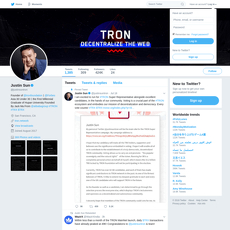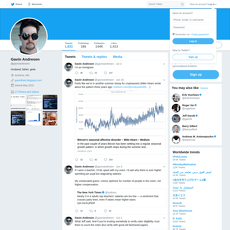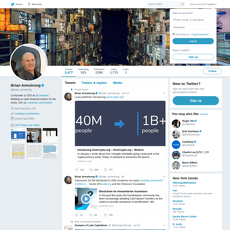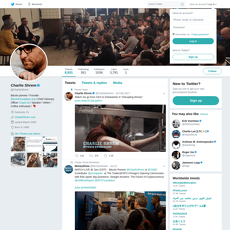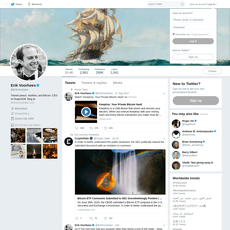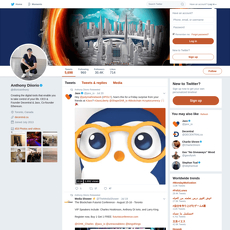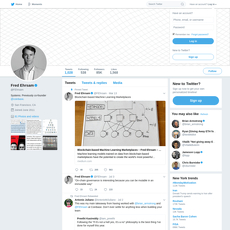Max Keiser: Cis Male Review
Max Keiser: Cis Male
twitter.com
Max Keiser: Cis Male Twitter Review Guide — Everything You Need To Know (with FAQ)
Ever scroll through @maxkeiser, feel the heat of the takes, and wonder what’s signal, what’s theater, and what’s actually useful for your crypto game? Good. That curiosity is your edge.
You’re reading this on cryptolinks.com — and I’m treating this like any of my reviews: clear, practical, and focused on helping you make better decisions.
Not financial advice. Treat Twitter as input, not instruction.
The problems people run into with @maxkeiser
His feed is bold, fast, and sometimes polarizing. That’s part of the appeal. It’s also where beginners, and even pros, get tripped up.
- Maximalist rhetoric vs. market reality: If you’re new, it’s easy to confuse conviction with proof. Strong tone ≠ verified facts.
- Memes ≠ thesis: Entertainment drives engagement, not always accuracy. Fun to read; risky to trade.
- Headline chasing: During ETF rumors, macro prints, or El Salvador headlines, the timeline spikes. Many jump early and get whipsawed.
- Politics in the mix: Policy and geopolitics add context, but they can also bias how you interpret price action.
- Echo-chamber risk: If you only follow voices that confirm your view, you’ll miss key risks or opposing data.
This isn’t just opinion. A string of studies shows how social media can amplify overconfidence and short-term noise:
- Sentiment moves price—then often mean reverts: Research on Bitcoin and Twitter/Reddit sentiment finds short-term impacts on returns and volatility, with frequent reversals when the hype fades (e.g., Garcia & Schweitzer; Mai et al.).
- False news spreads faster than truth: On Twitter, misleading claims travel quicker and farther than corrections (Science, Vosoughi–Roy–Aral). If there’s no source link, pause.
- Overtrading hurts performance: Behavioral finance work (Barber & Odean) shows that emotion-fueled activity tends to reduce returns—exactly what hot timelines can trigger.
Real-world example? When major Bitcoin headlines hit—like ETF speculation or surprise macro data—his replies and quote-tweets explode. I’ve watched traders pile into the first impulse move, only to see price snap back within hours. That’s not on Max; that’s on how people use Twitter. The fix is simple: treat his feed as a narrative scanner, then verify.
My promise: a simple, useful review you can act on
I’m going to keep this straightforward and practical. By the end, you’ll know exactly how to read his feed, where the value is for Bitcoiners and traders, and how to separate entertainment from actual signal—without getting lost in the noise.
What you’ll get in this guide
- A quick profile and context so you understand his stance and bias before you interpret a single tweet
- A practical look at his content patterns—what he posts, when, and why it matters
- How to use his feed whether you’re Bitcoin-only, trading narratives, or just crypto-curious
- Fast fact-check tools to verify claims and headlines in minutes
- A friendly FAQ based on what people actually ask (yes, I pulled from common Google questions)
- My final take on whether you should follow—and how to do it without wrecking your process
Ready to make his timeline work for you instead of your emotions? Up next: who Max Keiser is, why his Twitter matters in crypto, and the lens you should use when you read him. Curious what his background and media presence signal about the kind of information you’ll see?
Who is Max Keiser and why his Twitter matters in crypto
Quick background and media presence
Max Keiser is one of those rare voices who’s been saying “Bitcoin, not banks” since back when it got you laughed out of the room. He hosted The Keiser Report for years, now co-hosts the Orange Pill Podcast, and he’s been active around El Salvador’s Bitcoin era alongside Stacy Herbert (who helps lead the country’s National Bitcoin Office). That proximity gives him a front-row view into nation-state adoption — the stuff that turns Twitter threads into policy headlines.
Real-world touchpoints that make his feed useful:
- El Salvador’s Bitcoin Law (2021): when the law turned BTC into legal tender, his timeline amplified on-the-ground clips and policy snippets. If you want a refresher on the law itself, here’s a straightforward overview: Bitcoin Law (El Salvador).
- ETF milestones: when the SEC approved spot Bitcoin ETFs in January 2024, his commentary captured the “macro narrative” spike as it happened. The formal confirmation for your bookmarks: SEC press release 2024-4.
- Mining/adoption anecdotes: he frequently highlights mining, energy angles, and network stats; if you want to sanity-check what you see, keep mempool.space handy to look at fees, hashrate, and mempool conditions in real time.
“Strong tone isn’t strong evidence. Your edge is calm verification.”
His stance and biases (so you can read him right)
Understanding his lens helps you get value without getting dragged into the mud. He’s not a neutral wire service — he’s conviction-first.
- Bitcoin maximalist: BTC is the base layer; everything else is a distraction or a trade at best.
- Anti-fiat and anti-bank narratives: expect “fiat is failing” framing, especially around inflation, bank stress, or monetary policy shifts.
- Pro self-custody and mining: he’s big on energy narratives, mining security, and nation-state accumulation.
- Confrontational tone: memes, jabs, and provocations are part of the package — great for engagement, not a substitute for a source link.
Why this matters for you: research keeps showing that social media mood can influence crypto markets and risk-taking. If the rhetoric is heated, your brain might speed up before your process does.
- Early evidence that online mood can sway markets: Bollen et al., PNAS (2011).
- Crypto-specific studies link attention/sentiment with returns and volatility: see Urquhart, Finance Research Letters and Mai et al., SSRN.
Translation: if a tweet makes you feel like smashing the buy/sell button, that’s your cue to slow down.
Why people pay attention
Plenty of crypto accounts are loud. Few are both loud and early on narratives that become table talk across Bitcoin circles. That’s where his feed earns a spot on your watchlist.
- Early narrative surfacing: he’s quick on macro headlines (CPI days, rate decisions), ETF/market structure shifts, and adoption stories.
- Proximity to policy: involvement around El Salvador means you’ll often see hints, clips, and commentary that become broader coverage later. For context, follow @BITCOINOFFICE and @stacyherbert alongside him.
- Conviction and framing: whether you agree or not, a strong frame can help you spot where Bitcoiners will focus next — useful for building your watchlist or research queue.
- Media spillover: clips from Orange Pill, interviews, and live reactions compress hours of headlines into a few high-energy posts.
I think of his account like this: fast, conviction-heavy radar for Bitcoin and policy stories. You bring the filter; he brings the spark. The trick is knowing what shows up most, when, and which posts tend to carry real signal.
So what actually hits your timeline when you open his profile? Next, I’ll map the main content types, when he posts, and the quick tells I use to separate “entertaining” from “actionable.” Ready to see how to sort it fast?
What you’ll actually see on @maxkeiser
I read @maxkeiser the same way I read a fast-moving order book: lots of motion, a few clear tells, and moments where the tempo itself is the message. If you know what to watch for, his timeline can surface useful Bitcoin narratives quickly—without letting the theatrics pull you into bad decisions.
Main content types
Bitcoin advocacy and macro takesExpect rapid-fire reactions to CPI prints, bank stress headlines, ETF flows, and debt/fiat fragility. You’ll often see lines like “fiat is failing” paired with a chart or article. When CPI surprises or the DXY jolts, he tends to frame it as fuel for the Bitcoin thesis. That framing is a narrative accelerant—useful for awareness, not a trade by itself.
El Salvador adoption updates and commentaryHe amplifies stories tied to Bitcoin in El Salvador—policy notes, on-the-ground anecdotes, and clips related to mining, tourism, or infrastructure. If there’s movement around digital securities, mining announcements, or official statements from government accounts, you’ll likely see it there first. Treat those posts as pointers to go check official channels or press releases.
Memes, jabs, and provocative languageCaps, short taunts, and tribal memes are part of the brand. That content drives engagement and can sway sentiment. Research on social sharing shows high-arousal language spreads faster (Berger & Milkman, 2012), which helps explain the reach—but remember: virality isn’t validation.
Media clips, podcast promos, and interviewsShort video segments and show links provide longer-form context. These can be signal-rich when guests discuss mining economics, energy mix, or policy details. If an interview includes specific metrics or dates, that’s your cue to note it and verify the claims later.
Geopolitics and “fiat is failing” narrativesCommentary often ties global events—capital controls, currency slippage, bank troubles—back to the Bitcoin story. There’s evidence that social attention can correlate with crypto price action (Mai et al., 2018), but correlation doesn’t equal a trade signal. File these posts under “narrative context.”
Frequency and timing
Activity comes in bursts, especially when Bitcoin rips or macro headlines break. You’ll see:
- Spike windows: CPI/FOMC days, ETF rumors/flows, banking/FX stress, and high-volatility sessions.
- Retweet clusters: A string of supportive takes and clips to amplify a storyline (e.g., policy progress, mining wins, or anti-fiat headlines).
- Reaction cadence: Fast, then faster—especially when a narrative catches momentum. That speed is the point; it’s a nudge to pay attention, not an instruction to act.
If you’ve ever felt your heart rate rise following a tweetstorm, that’s normal. Behavioral finance calls it the affect heuristic: strong emotion can shortcut analysis. Knowing that helps you slow down when it counts.
Tone and expectations
Blunt, theatrical, conviction-heavy. It’s part entertainment, part signal boost. The upside: you won’t miss where the conversation is heading. The risk: tone can color your judgment and anchor you to a conclusion before you’ve seen the data. Quick reminder on two biases that show up here:
- Availability bias: The louder the take, the more “true” it feels in the moment.
- Confirmation pull: If you’re already bullish Bitcoin, spicy anti-fiat posts feel like proof—even when they’re just opinion.
“Filter the vibe, extract the data.”
Signal vs entertainment (how I sort it)
I separate his feed into two buckets and act accordingly:
Signal I watch for- Policy and adoption breadcrumbs: Mentions of legislation, official events, or statements tied to real names, places, and timestamps. Bonus points if there’s a link to a government site, press release, or reputable outlet.
- Mining and energy insights: Clips with operators, location-specific details (capacity, energy source), or references you can check against independent reports.
- Macro headlines: Links to CPI/Fed calendars, banking news, or ETF flow summaries. These help set your “why now?” narrative for the day. Validate with a market calendar or verified data source.
- Guest discussions with specifics: Numbers, dates, contracts, jurisdictions. Anything you can screenshot and verify later belongs in your notes.
Entertainment I enjoy but don’t act on- One-word taunts, all-caps victory laps, and dunk retweets.
- Price targets with no timeframe, no model, no context.
- “This changes everything” claims without a single source link.
As a sanity check, I ask: Does this post include a primary source, a measurable claim, or a link I can verify? If the answer is no, it lives in the entertainment bucket until proven otherwise. If the answer is yes, it goes into my “review” list with a note to confirm against a chart, an official account, or a calendar.
Want to turn that firehose into a practical edge—without getting caught by the noise? Keep going; I’ll show you how I set filters, what I mute, and the quick checks I run before I ever place a trade.
How to use his feed without getting wrecked
“What you see is all there is.” — Daniel Kahneman. Twitter makes loud things look true. Your edge is to slow down and verify.
I treat @maxkeiser’s timeline like a high-energy scanner, not a signal generator. It can surface adoption nuggets and macro pressure points early, but emotion and speed are the traps. Here’s how I turn his posts into useful inputs without letting the adrenaline tax my wallet.
For Bitcoin-only readers
If you’re here for Bitcoin only—policy, mining, adoption—use his feed to spot stories, then confirm them with primary sources and neutral data. A few practical moves:
- Adoption updates: When he flags a city or country doing Bitcoin payments or legal changes, search for the official government or central bank announcement. Cross-check with reputable media (Reuters, Bloomberg) or direct releases.
- Mining and hashrate: If he mentions new facilities or energy partnerships (e.g., geothermal or flared gas), look for company filings, energy ministry posts, and network metrics. Use public dashboards like mempool.space (fees/blocks), and compare hashrate changes with multiple trackers.
- Macro + policy chatter: Treat it as a heads-up. Pull the actual documents (e.g., SEC, Treasury, BIS) and read the summary. Keep a “policy watch” note with dates and links.
Real example: If he posts that a national pension fund is “going Bitcoin,” I immediately look for a press release on the fund’s website or a regulator’s site. No primary link? I park it in a “rumor” folder and wait. Attention-driven buying is a known bias—Barber and Odean (2008) showed investors chase attention and underperform because of it. Don’t be the chart that study describes.
For traders and active investors
His feed is perfect for building a narrative-driven watchlist—just don’t press the green button off a tweet. Here’s a process that’s saved me more than once:
- Topic → Ticker map: If he’s hammering “ETF flows, miners, nation-state adoption,” map it to BTC, miner equities, and correlated pairs. Add them to a watchlist with alerts.
- Confirmation checklist before entries:
- Price and volume break beyond a key level with volume > 20D average
- Open interest expanding with supportive funding (not wildly positive on a long breakout)
- Options skew (25D) and IV not screaming blow-off
- News confirmed twice by credible sources or filings
- Risk first: Define invalidation on the chart, size for a normal stop (not a “Twitter stop”), and set alerts to manage the trade—don’t babysit the feed.
Real example: On an “ETF approval imminent” day, instead of chasing, I set alerts at prior day high and weekly level, watch CME basis for a regime shift, and monitor open interest for healthy build, not one-sided FOMO. Studies like Tetlock (2007) and Sprenger et al. (2014) show that news and social sentiment can move prices temporarily—but reversals are common when the attention window closes.
My quick fact-check workflow
When a post feels explosive, I run this 3-step filter in minutes:
- Verify source: Is there a primary link (government, regulator, company filing, official account)? If it’s a screenshot, search the text line and date. No source? It’s opinion until proven otherwise.
- Cross-check data:
- On-chain: mempool congestion, fees, or hashrate spikes on mempool.space or similar
- Market: BTC volume vs. 20D avg, funding, OI, options skew (TradingView + your derivatives data)
- Macro: event calendar (Fed, CPI, jobs) to avoid confusing macro noise with crypto news
- Time filter: I wait for a second credible confirmation or a timestamped document. If it’s real, the market will still be there in 30–60 minutes. That pause is where a lot of regret gets avoided.
Pro tip: If a claim mentions a number (adoption rate, facility output, treasury purchase), record the figure and check it a week later. Misinformation often mutates; your notes won’t.
Make Twitter work for you
You don’t need to consume every post to get the value. Tune the feed so signal finds you:
- Create a focused list: Add @maxkeiser plus 10–15 macro, policy, and Bitcoin data accounts. Name it “BTC Macro + Policy” and use it during market hours only.
- Mute with intent: Mute keywords that lead you off-mission (e.g., specific political flame-words, ticker spam, “wen” memes). You’ll still get the big themes without the cortisol.
- Smart notifications: Turn on alerts during key windows (CPI, FOMC, ETF deadlines). Off outside of those. You control the tempo.
- Bookmark like a librarian: Save only posts with sources. Tag them: “policy,” “mining,” “adoption,” “macro.” Review weekly, prune hard.
- Use advanced search: Search by “from:maxkeiser (ETF OR mining OR El Salvador) filter:links” to surface posts with sources fast.
- Separate narrative from action: Keep a split-screen habit—feed on one side, chart/data on the other. If the chart disagrees with the tweet, the chart wins.
One more thing: excitement isn’t evidence. If a post makes your heart rate jump, stand up, get water, and re-check the source. The market rewards patience, not pulse spikes.
Curious how trustworthy his takes are overall, whether he ever backs altcoins, or how to spot a “hot take” that needs cooling off? I’ve collected the most-asked questions—and the blunt answers—next.
FAQ: Real questions people ask about Max Keiser and his Twitter
“Strong tone ≠ strong evidence.”
Fast answers to popular queries
Is Max Keiser trustworthy for Bitcoin info?
He’s consistent on Bitcoin and quick to amplify adoption stories. I treat his posts as early flags—not final facts. If he points to a policy change or headline, I look for a primary source (official statement, filing, or press release) before I act.
Does he promote altcoins?
No. He’s a long-standing Bitcoin maximalist and usually skeptical of altcoins. If you’re looking for multi-chain coverage, you won’t find it here.
What’s his connection to El Salvador?
He frequently comments on El Salvador’s Bitcoin policies and appears alongside Stacy Herbert and the local Bitcoin community. Expect commentary on mining, energy, and adoption narratives from that angle.
Is his content investment advice?
It’s opinion and commentary. Never trade based on a single account. A good rule: if a tweet is the only reason for a trade, the trade is too weak.
What does “cis male” mean in this context?
It’s a gender identity descriptor. It doesn’t change how I evaluate the utility of market or policy comments.
Does his feed move markets?
In Bitcoin circles, his posts can nudge sentiment and surface narratives fast. But broader price action reacts more to big catalysts (ETF approvals, rate decisions, major policy announcements). Use his feed to spot the narrative early, then verify with data.
How do I avoid getting caught by hype or FOMO?
Slow down: breathe, check for a source, set a tiny time delay (even 10–15 minutes can reveal corrections or clarifications). Emotion drives clicks; discipline drives PnL.
Quick sample that shows the point: When the SEC approved spot Bitcoin ETFs in January 2024, hype went wild across Crypto Twitter. I waited for the SEC’s official press release and checked the initial volumes on reputable market dashboards before making any decisions. You’ll save yourself many bad trades by building this tiny pause into your workflow.
What he tends to get right vs where to be careful
Gets right
- Early amplification of adoption narratives: He often surfaces policy chatter, mining headlines, and “Bitcoinization” talking points before they hit mainstream feeds.
- Conviction on BTC’s long-term thesis: If you need a shot of macro conviction, his feed delivers that energy (and sometimes that’s exactly what keeps people patient through drawdowns).
- Spotlighting fiat pressure points: He frequently points to inflation, debt, and currency debasement themes—useful prompts to check CPI, DXY, and balance sheet data.
Be careful
- Emotion during volatility: Spiky moves = spiky takes. Great for engagement, bad for decision-making under stress.
- One-sided lens on altcoins and TradFi: Whether you agree with his view or not, remember it’s a maximalist stance. Balance it with neutral sources.
- Theatrical language: Strong rhetoric can make weak evidence feel strong. Re-read without the adjectives; does the claim still hold?
Why this matters: Research finds that emotionally charged posts spread faster and farther on social platforms. In one Science study, false or sensational news on Twitter spread more rapidly than the truth, largely due to novelty and emotion (Vosoughi et al., 2018). Another line of work shows attention-driven buying is a real bias—traders gravitate to what’s loud and visible (Barber & Odean). Translation: the spicier the take, the more you need to cool it with facts.
How to spot when a hot take needs cooling off
No source link? Pause. If it’s real, there’s usually a filing, press release, official account, or reputable outlet reporting it.
Single anonymous quote or screenshot? Wait for a second credible confirmation. Screens can be old, cropped, or out of context.
Price target with no timeframe, thesis, or data? Entertainment, not a trade plan. Ignore for execution.
Old clip framed as new? Check the date. Recycled content is engagement gold and trading poison.
Apocalyptic or euphoric language during fast moves? Zoom out to a daily chart. If the story dies on higher timeframes, the take likely will too.
“Everyone knows” framing? Classic herd cue. If “everyone knows,” price usually already does.
Real-world example: When you see “fiat is failing” alongside a dramatic chart, I open two tabs: CPI or PCE from the BLS and the DXY on FRED. If the narrative and the data don’t rhyme, I park it. Simple habit, huge ROI.
Pro move I use in seconds: If a tweet references network stress, I check mempool backlog and fees. If it cites miners, I look at recent difficulty and hashrate prints. If it points to policy, I scan the official government or regulator account. Ten taps you’ll never regret.
Want the exact dashboards, calendars, and links I hit to sanity-check his tweets in under 60 seconds—without getting lost in 20 tabs? Keep going; I’ll share every tool and how I use them side by side so you can copy the workflow instantly.
Tools, links, and resources I use to sanity-check his tweets
When a hot take hits my feed, I don’t argue with it—I test it. Here’s the exact toolkit and a few real-world workflows I use to separate narrative sugar from usable signal.
Official and related links
- Primary feed: https://twitter.com/maxkeiser — I click through to original sources from here, not screenshots.
- Long-form context: Orange Pill Podcast — useful for catching the full argument behind a spicy tweet.
- Key context accounts:
- @stacyherbert — frequent policy and El Salvador updates.
- @BitcoinBeach — on-the-ground adoption snapshots.
- @bitcoinofficesv — official El Salvador Bitcoin Office updates (ONBTC).
Data, charts, and on-chain I actually use
- TradingView — clean charts, custom alerts, and quick cross-asset checks (DXY, rates, gold, BTC).
- Mempool.space — fees, mempool backlog, difficulty estimates, and block-by-block reality checks.
- Glassnode or Coin Metrics — on-chain trends like miner flows, HODL waves, realized price bands, and supply dynamics.
- Federal Reserve calendar — for rate decisions, minutes, and surprise meetings.
- Trusted macro calendars (to time the narrative against data drops):
- ForexFactory
- Investing.com Economic Calendar
- U.S. CPI (BLS)
- Regulatory source of truth:
- SEC EDGAR — filings for ETFs, issuers, and enforcement clues.
- U.S. Treasury press releases — sanctions, AML actions, policy shifts.
How I pressure-test a claim (real examples)
“Fees are exploding—network is congested!”- Open mempool.space and check:
- Unconfirmed transactions (is the backlog actually growing?)
- Recommended fees (compare current sat/vB to 24h ago)
- Last 12 blocks (are blocks full and fee-heavy?)
- If the mempool is flat and fees are stable, it’s probably narrative heat, not network stress.
- Open mempool.space and check:
“ETFs are gushing inflows today.”- Intraday: treat it as chatter. Set a TradingView alert on BTC for key levels so you don’t FOMO.
- End of day: check issuer press, EDGAR for creations/redemptions, and reputable ETF flow trackers. If inflows don’t show up there, it didn’t happen.
“Fed emergency meeting incoming.”- Check the Fed calendar and Board notices of closed meetings (posted on the Fed site). Rumors without postings get low weight.
- Set alerts around DXY and 10Y yield on TradingView—if it’s real, rates and the dollar usually move first.
“El Salvador just announced X.”- Look for confirmation on @bitcoinofficesv or @stacyherbert. If it’s policy-level, you’ll often see an official statement or clip.
- For adoption anecdotes, cross-check with @BitcoinBeach or recent local coverage.
“Miners are hoarding/selling—supply shock incoming.”- On Glassnode/Coin Metrics, review:
- Miner Net Position Change (are miner balances rising or falling?)
- Hashrate and Difficulty (is security rising and costs changing?)
- Exchange flows (are coins actually moving to exchanges?)
- If data contradicts the take, I tag it as narrative, not signal.
- On Glassnode/Coin Metrics, review:
“Breakout confirmed.”- On TradingView, I check:
- Weekly and daily structure (is this a higher high + higher low?)
- Volume (is it above 20–50 day average?)
- Confluence (DXY down, risk-on up?)
- No volume = no validation. I’ll wait for a retest or higher-timeframe close.
- On TradingView, I check:
Quick guardrails backed by research
Attention isn’t evidence. High-engagement posts push us to act fast, but research shows attention-driven trades often underperform.
- All That Glitters (Barber & Odean, 2008) — investors chase attention; it’s a bias, not an edge.
- Twitter Mood Predicts the Stock Market (Bollen et al., 2011) — sentiment can sway markets, but it’s noisy and timing-dependent.
- Bitcoin meets Google Trends and Wikipedia (Kristoufek, 2013) — search interest correlates with price moves; hype spikes don’t guarantee direction.
- How Influential Tweets Move Crypto (Ante, 2021) — star accounts can move price short-term; it fades fast without confirmation.
Takeaway: use social posts to know what to check, not what to trade. Let the data do the talking.
Use them as complements, not substitutes, for your own judgment.
Want the simple rule I use to decide whether to even follow an account like this in the first place? That’s up next—plus my checklist so you never confuse narrative with evidence again.
Should you follow @maxkeiser? My final take
Who gets the most value
If you’re focused on Bitcoin and you care about adoption, policy, and the “money vs. fiat” conversation, following him pays. His feed is a loud radar for what people will talk about next. If you want strictly neutral data and quiet charts, follow him with filters, and pair it with objective dashboards. That combo gives you early narrative detection without the bias tax.
Here’s how that looks in practice:
- Adoption and policy watchers: When he cheered El Salvador’s regulatory steps toward the “Volcano Bond” in late 2023, I marked my calendar for official docs and later checked for filings and on-chain breadcrumbs. The signal wasn’t the cheer; it was the timeline and the involved agencies.
- Market participants: During the January 2024 spot BTC ETF launch week, the useful follow-up wasn’t any victory lap—it was real daily flow data. I tracked issuer flows and creations (publicly aggregated here: Farside ETF Flow) and waited for price/volume confirmation instead of trading off anyone’s caps-lock.
Pro tips to stay balanced
- Separate narrative from data: I literally keep two notes: one labeled “Narratives” (headlines, claims, memes) and another labeled “Data” (links, filings, charts). If a point can’t cross from Narrative → Data, it doesn’t move my portfolio.
- Add a second source before you act: The October 2023 false “spot ETF approved” rumor sent BTC ripping for minutes before retracing. A simple two-source rule would have saved a lot of people whipsaw pain. Example coverage: Bloomberg’s write-up of the erroneous report.
- Use lists, mutes, and alerts: I keep his account in a “BTC: Policy + Macro” list, mute bait keywords I don’t need, and set price alerts separately so the feed doesn’t push me into FOMO.
- Treat tone as décor, not data: Strong tone ≠ strong evidence. Entertaining? Sure. Actionable? Only when backed by something verifiable.
Why this works: Research keeps reminding us that social chatter can move crypto in the short run—but it fades fast. Twitter sentiment has shown short-lived predictive power for BTC returns, especially during attention spikes (Kraaijeveld & De Smedt, 2020). On the flip side, classic “attention-driven trading” tends to lead retail into bad entries (Barber & Odean). Translation: use the feed to spot what’s hot, then let the data decide.
Bonus: a simple checklist before you act
- Do I have a primary source? A filing, an official statement, a contract address, or a credible government/issuer link.
- What does the chart say without the tweet? Look at structure, volume, and liquidity. If you erased the tweet, would you still take the trade?
- Is this confirmed news or speculation? If it’s “hearing” or “rumor,” cool your heels until there’s a second reputable confirmation.
- What’s my invalidation? If you can’t name a level or condition that proves you wrong, you’re not trading—you’re hoping.
Bottom line: use loud narratives to locate opportunities, and quiet data to execute.
Conclusion
@maxkeiser is a high-energy narrative scanner for Bitcoin and macro themes. I treat his feed as input, not instruction. When I keep my filters tight—verify claims, wait for confirmations, and stick to my plan—I get the upside (early signals, conviction) without the downside (whipsaw trades, bias traps). That’s the win.
CryptoLinks.com does not endorse, promote, or associate with Twitter accounts that offer or imply unrealistic returns through potentially unethical practices. Our mission remains to guide the community toward safe, informed, and ethical participation in the cryptocurrency space. We urge our readers and the wider crypto community to remain vigilant, to conduct thorough research, and to always consider the broader implications of their investment choices.




